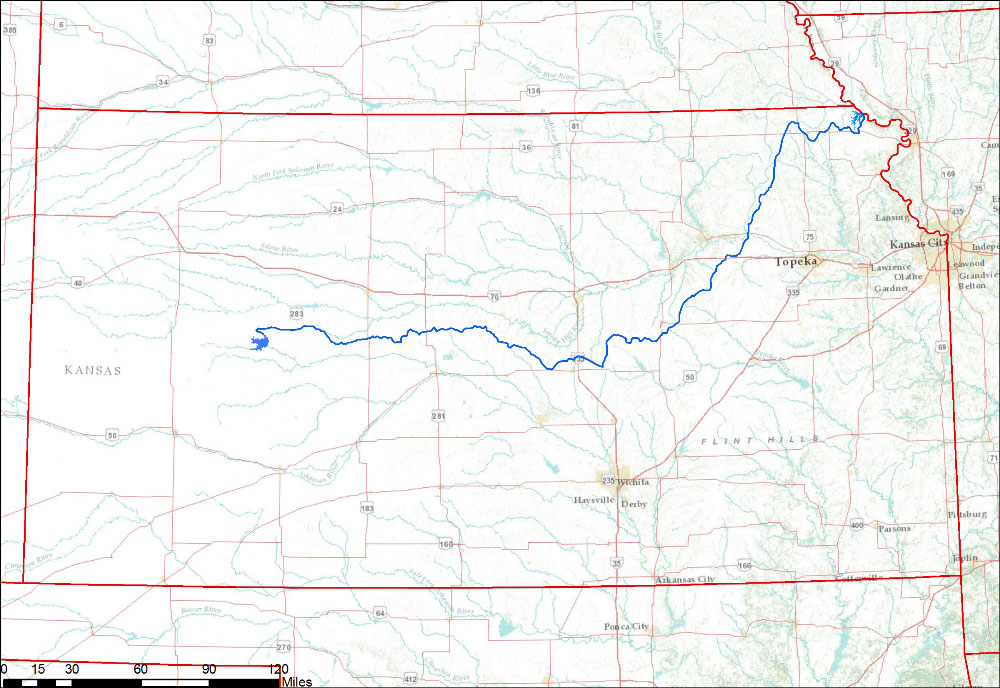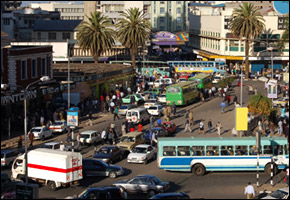Kansas and Army Corps Revive Study to Ship Water from Missouri River to Ogallala Aquifer
In addition to reducing demand from its key aquifer, Kansas wants to study the cost of importing water to the High Plains. But will this cause conflict with neighboring states that also use the river?

By Brett Walton
Circle of Blue
GARDEN CITY, Kansas – In response to rising concern about diminishing water supplies and the security of grain production in Kansas, state officials and the U.S. Army Corps of Engineers have agreed to re-evaluate a seminal 1982 federal water supply study that proposed transporting billions of gallons of water annually from the Missouri River to farms across much of the nation’s largest wheat-growing state.
“I’m comfortable if you say it’s a Roman project in the 21st century. The aquifer is a question that has to be dealt with.” –Mark Rude, executive director of the
SW Kansas Groundwater Management District
The new analysis, to be started this year and completed in 2015, will reassess the Kansas Aqueduct, one of four projects that were evaluated 31 years ago. The goal of these projects was to provide water to High Plains farms in Kansas and to reduce the draw on the Ogallala Aquifer, the region’s primary source of water for irrigation; none of the water-transport projects that were evaluated in the 1982 study were built, however.
But the Kansas Aqueduct — which would draw water from a turn in the Missouri River about 145 kilometers (90 miles) upstream of Kansas City and drop it into a reservoir roughly 600 kilometers (375 miles) away in western Kansas — is getting a second look.
The cost of the new $US 300,000 study will be shared equally by the state and the federal government, said Mark Rude, executive director of the Southwest Kansas Groundwater Management District. Rude added that the region’s strong farm economy and the urgency of extending the Ogallala’s life as a source of water to agriculture make this a useful period to reconsider the Kansas Aqueduct.
“The Kansas Aqueduct Project must be pursued while production income, property values, and the economic system are in place to support the project,” Rude wrote in a June letter to state water officials.
More Water at Much Higher Cost
For nearly a year, Rude has stumped across the state to rally financial support for new analysis of an old idea – a manmade river from northeast Kansas to the High Plains.
The Kansas Aqueduct would draw water from the Missouri River into a canal that is 41 meters (137 feet) wide and 7 meters (23 feet) deep. The aqueduct was the most visible water-supply project to emerge from the High Plains-Ogallala Aquifer Study, authorized by Congress in 1976 to look at ways to develop alternative water supplies for the six states that rely most heavily on the Ogallala, which holds trillions of gallons of water and is steadily declining.
Because of High Plains geology and climate, water percolates into the aquifer each year in centimeters (inches). But in order to sustain a thriving grain and cattle industry, water is pumped out in meters (feet).
The farmers and cattlemen in Rude’s district in southwest Kansas know this fact all too well. Rude told Circle of Blue that current rates of groundwater extraction – mining, really – are about 9 percent sustainable. In other words, the amount of water pumped out of that part of the aquifer would have to be cut by 90 percent to find a balance. Such a reduction would decimate the region’s towns.
Over the years, all that water has created a more prosperous life on the plains than that which the early pioneers could ever have imagined. The economic structure, formidable for the time being, collapses without water.
“Everything we need is here already,” Rude said, talking about the grain elevators, equipment dealers, and related agricultural infrastructure in western Kansas. “But new investment needs water confidence. How do we provide that when we are cutting water use? It’s ideal to have both cuts and new supplies and manage the aquifer more like a reservoir.”
Farmers in northwest Kansas, in Sheridan County, have agreed to self-imposed restrictions on the amount of water that they draw from the Ogallala. But it is an experiment that has yet to catch on elsewhere in the state.
Economics are foremost in Rude’s mind, because the aqueduct would be a whopper of a project — at least double the estimated $US 3.6 billion price tag from three decades ago and comparable in scale to massive water diversions like the 540-kilometer (360-mile) Central Arizona Project that was approved before the Carter administration and which was built mostly with federal money.
Rude scoffs at the suggestion that a Kansas Aqueduct is a relic of a by-gone age.
“I’m comfortable if you say it’s a Roman project in the 21st century,” he said, recalling the channels that satiated Caesar’s capital, more than two millennia ago. “The aquifer is a question that has to be dealt with.”
“There’s enough money to scratch the surface.”–John Grothaus, chief of water-project planning
U.S. Army Corps, Kansas City District
According to the 1982 study, the Kansas Aqueduct would require at least 16 pumping stations to lift the water nearly 550 meters (1,800 feet) over its 600-kilometers (375-mile) course to the High Plains. The water would be drawn from wells drilled next to the Missouri River, and the aqueduct would be designed to divert water when the river is running swollen. As much as 4.9 billion cubic meters (1.3 trillion gallons) could be moved each year, though less than half of that – 2 million cubic meters (521 million gallons) or roughly 5 percent of the river’s average annual runoff – would be a firm supply, Rude said. A terminal reservoir to hold the water would also be needed, as well as secondary canals to move water from that reservoir to users across the region.
These secondary canals were not included in the $US 3.6 billion construction cost from the 1982 study, which also estimated an annual operating cost of $US 413 million.
Rude acknowledges that the days of deep federal investment are probably over. Farmers, who now pay only for the energy to pump water, and other local users will have to shoulder the cost, and that represents the chief uncertainty for the project. How much will water cost? Will people pay for it? Are there possible cost-sharing partnerships with cities and industries along the route?
Because of the small amount of funding, the study will have a narrow focus, said John Grothaus, chief of water-project planning for the Kansas City District of the Army Corps.
“There’s enough money to scratch the surface,” Grothaus told Circle of Blue. That means new estimates for the cost of construction and potential water demand but not for an environmental analysis or an assessment of economic tradeoffs.
NIMBY?
Unlike many other basins in the Western United States, the Missouri River does not have a compact that divides water among its ten states. That will likely lead to the project’s second hang up: opposition from Kansas’ neighbors.
“These proposals… face huge political and economic obstacles, so [we have] not taken a position yet. We will wait to see the results of the update.”
–Mike Hayden, executive director of the
Missouri River Association of States & Tribes
“Whether sister states are comfortable is a conversation to be had,” Rude said.
For now, neighboring states are watching to see what happens with the study, said Mike Hayden, executive director of the Missouri River Association of States and Tribes (MoRAST), a basin forum comprised of five states and a tribal coalition.
“These proposals have been around long before the 1982 study,” Hayden, governor of Kansas from 1987 to 1991, wrote in an email to Circle of Blue. “They face huge political and economic obstacles, so MoRAST has not taken a position yet. We will wait to see the results of the update.”
Similar projects have raised eyebrows among Missouri River Basin states: a pipeline from the Missouri River to Colorado’s Front Range that was included in the federal Bureau of Reclamation’s recent Colorado River Basin study is just one example. Even states farther downstream in the Mississippi River Basin, remembering the barges stranded along a depleted river during the 2012 drought, might oppose such a large-scale diversion, if it threatens the multi-billion-dollar shipping industry — even if the aqueduct only withdraws water during periods of high river flows.
Kansas does currently take some water from the Missouri River, mostly by cities and industries in the state’s northeast corner, and the state is willing to accept more.
“We consider the Missouri River open for new water-rights development,” Tracy Streeter told Circle of Blue. Streeter is director of the Kansas Water Office, which will put $US 50,000 toward the aqueduct analysis.
Still, Streeter said that the state considers a water-rights application from Rude’s groundwater district premature.
“We consider the Missouri River open for new water-rights development.”
–Tracy Streeter, director
Kansas Water Office
“We don’t have a handle on the place of use or what the beneficial uses will be,” Streeter said. “Until we really know who uses the water and where it comes from, an application is missing some pieces.”
Now that he has secured the money for the new study, Rude said the next decision that the groundwater district’s board must make is whether to go against the state’s wishes and apply for a water right from the Missouri River. Kansas water law generally follows the doctrine of prior appropriation, in which a pecking order for water is set by who claims it first. Putting a claim in today for the Missouri would establish the groundwater district’s place in line.
“We’re not picking a fight,” Rude said. “We have a need and a significant one.”
Brett writes about agriculture, energy, infrastructure, and the politics and economics of water in the United States. He also writes the Federal Water Tap, Circle of Blue’s weekly digest of U.S. government water news. He is the winner of two Society of Environmental Journalists reporting awards, one of the top honors in American environmental journalism: first place for explanatory reporting for a series on septic system pollution in the United States(2016) and third place for beat reporting in a small market (2014). He received the Sierra Club’s Distinguished Service Award in 2018. Brett lives in Seattle, where he hikes the mountains and bakes pies. Contact Brett Walton







Why does this article mention New Mexico, Oklahoma, and Texas (“…the Missouri River does not have a compact that divides water among its six states — Colorado, Kansas, Nebraska, New Mexico, Oklahoma, and Texas.”) when these three states are not in the Missouri watershed? And the article does not mention the many other states that are actually in the Missouri watershed, most notably the State of Missouri, which is immediately downstream of where this diversion would take place and would suffer the most from it? Despite this apparent confusion/omission, thank you Circle of Blue team for covering this important issue.
Andy, we inserted the wrong list of states in that reference. Those six – Colorado, Kansas, Nebraska, New Mexico, Oklahoma, and Texas – are the states that rely most heavily on the Ogallala Aquifer and would have received water from the Missouri/Mississippi River pipelines in the 1982 import study. It’s fixed now.
A fascinating concept, and a story that you are not likely to find anywhere else on the Internet. I’m sure the existence of the artificial canal’s water transfer capabilities will 1) help alleviate flooding in the headwater states; 2) allow for groundwater storage along the entire riverway; 3) lead to greater friction and posturing between watershed states. Surprising that local political figures have accepted that federal funding is not automatic, and that free market capitalists who benefit from the water supply should fund the project.
Kansas is one of the top beef producing states. Kansas and Nebraska product roughly 36% of the nations beef. Texas produces roughly 20% of the nations beef. All three of these states overlay the Ogallala aquifer. Over the past few year the aquifer has been depleted heavily because of the current drought. Farmer produce feed for cattle which is produced on irrigated land. If farmers are cut back 20% on irrigation cattle population will drop to 12% of current production (David Steward). Cattle production provides Kansas with $7.8 billion of economic revenue and beef packing plants provide Kansas with $29.8 billion in revenue. The aqueduct can provide cities with water during drought years as well. The city of Wichita, Salina, and Hays are also having water depletion problems. Having an aqueduct will provide security of water for everyone in Kansas